Spring. It is a time of rebirth. A time to shake off the chill of winter and make haste with plans for the new season. Tasks for our upcoming summer of sailing were sprinkled across the winter like a new fallen snow; little reminders that in a region with such strongly defined seasons like New England, one can’t be too tempted to placate the present without planning for the future.
In a parallel universe two seasons ago, we had made plans over the winter to leave Greece behind and sail west out of the Mediterranean and henceforth along the Iberian peninsula to cross the Bay of Biscay from Spain to France. We had read stories of the Bay of Biscay, nearly all of a dire nature. Monstrous waves – the kind that bury the bow in water – temperamental winds, a large enough expanse to be beyond immediate help, and a sudden change in depth forcing the incoming ocean swells into a witch’s cauldron halfway across. It wasn’t until our insurance company charged an additional premium and required additional safety gear onboard for the crossing did I start to take these stories more seriously. Among the gear, we were required to install a higher capacity bilge pump.
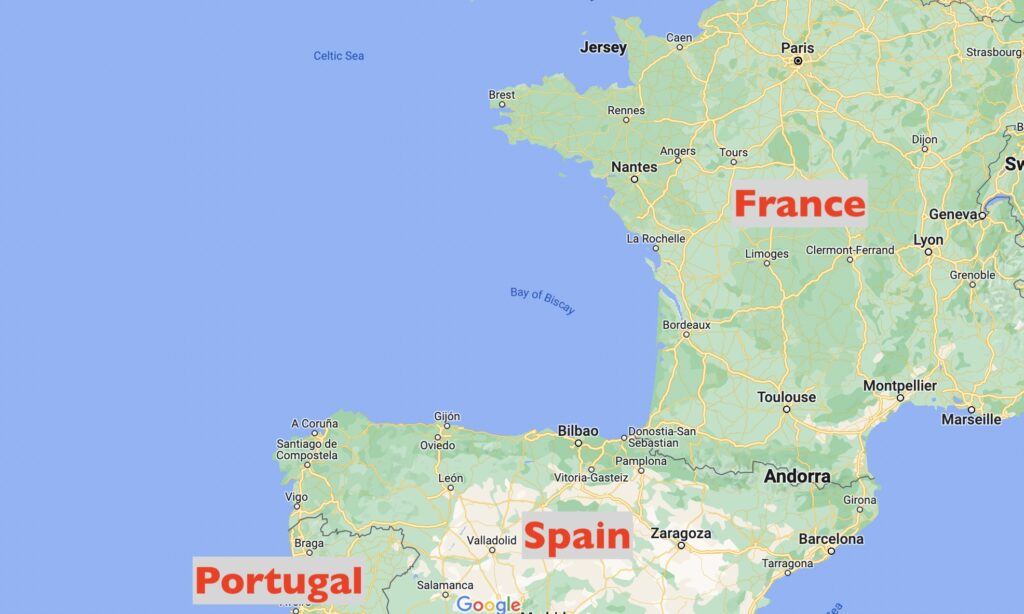
But like so many things, Covid got in the way. We spent the summer sailing Greek waters, never making it further west than the Ioanian Sea. That was all right. The tempestuous Bay of Biscay could be put off for another year while we sampled more tasty souvlaki.
Last year, with earnest plans made over the winter to position Sea Rose in Northern Europe, we once again set out from Greece to exit the Med. We made it through doldrums and high winds, orcas and grilled mussels, but stopped just shy of the Bay of Biscay, in the lovely little out-of-the-way town of Sada, nestled in the northwest corner of Spain, within the region of Galicia that no one we talked to back home had ever heard of save for our sophisticated local Spaniard, Lisa. We had navigated thousands of miles over the summer but it seemed to make little sense to tackle the Bay of Biscay in the Fall when storms and high winds would regularly roar across the coast and interior of Galicia. We kicked the can down the road a little further.
But you can only avoid the inevitable for so long. After re-upping our insurance to include the Bay of Biscay special premium for a third season, we knew we had to address the elephant in the room. Sada sits right on the southern edge of the Bay. Going north puts you right into the thick of it. Our usual spring shakedown of Sea Rose to work out any kinks from winter storage would have to be abbreviated. As soon as the weather was right, we would go. As we shared our plans with other boaters, we learned quickly that we’d be the exception on the Bay of Biscay. No one, it seemed, goes north in the spring. The main traffic is Brits and other Northerners heading south, fleeing the cold clutches of winter. We ran into many a merry boat crew, crossing the Bay and making earnest time to the fine weather of Mediterranean waters. We would be on our own for this northern passage. There would be no option to buddy boat.
However, we did have willing crew back home that wanted to take on a multi-overnight passage with the potential of rough weather to learn more about extended ocean sailing. Dan and Don had both been onboard Sea Rose before, but never close to the three night passage that would be required here. Karen and I eagerly took them onboard, welcoming the help that we desperately longed for and lacked last summer during our under-staffed overnight passages necessary to get out of the Med. Dan and Don were also intrigued by the possibility of sailing across the Atlantic with us in a few years with the ARC. Three nights across the Bay of Biscay seemed like a good introduction.
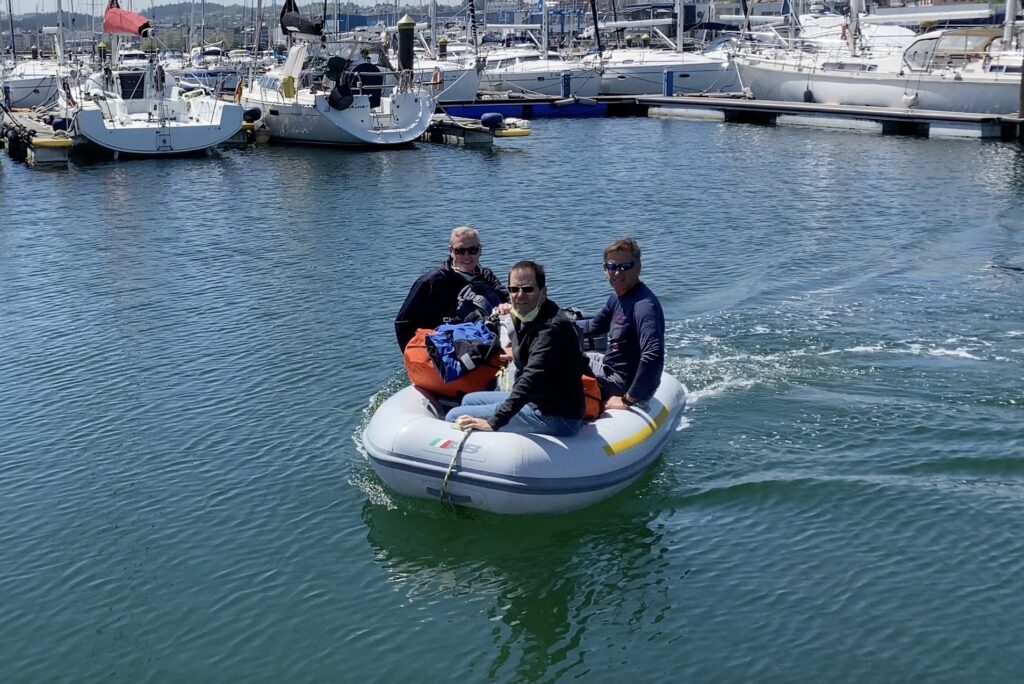
Karen and I had been watching the weather models incessantly for the last week and strong northerly winds were making havoc with our planned departure. Dan and Don had a week to spare onboard and we wanted to make this passage a productive one. The day that they walked onboard, a sliver of positivity came in the forecast. Northeast winds coming down the Bay were curving along the Galicia coast, giving us the possibility of a tack to the North, a bit out to sea from our destination to the Northeast, but with the possibility of wind shifts in the coming days.
We hurriedly provisioned at the convenient Carrefour right at the port, and completed some last minute projects onboard, including sending me up the mast. Our departure was set for the next morning, and a celebratory dinner ashore marked our eager anticipation to get underway.
Seas were placid and the early morning light magical on the water as we motored out of Sada, set deep into the interior. When Karen and I had first arrived in Sada, we were excited to escape the big ocean swells that had been rolling us for several days; I was pleased to see these big rollers absent today.
After a few hours clearing the coastline, the predicted easterly winds began to rise, and we were soon sailing a close-hauled course away from the coast, leaving the land in the hazy mist of the day. Quickly, the wind increased to 20 knots, heeling Sea Rose to an angle suitable for an introduction to ocean sailing but not convenient for making lunch or spending any quantifiable time down below. I offered to make sandwiches, which involved propping all of the ingredients in the valley formed by the angled galley counter and the normally vertical backsplash, grabbing a single piece of bread at a time while bracing myself to the three dimensional movement of rolling sideways and pitching forward. Staring down into the sea from the side porthole, a pale shade of green, made we wonder if we should market Sea Rose as a glass bottom boat.
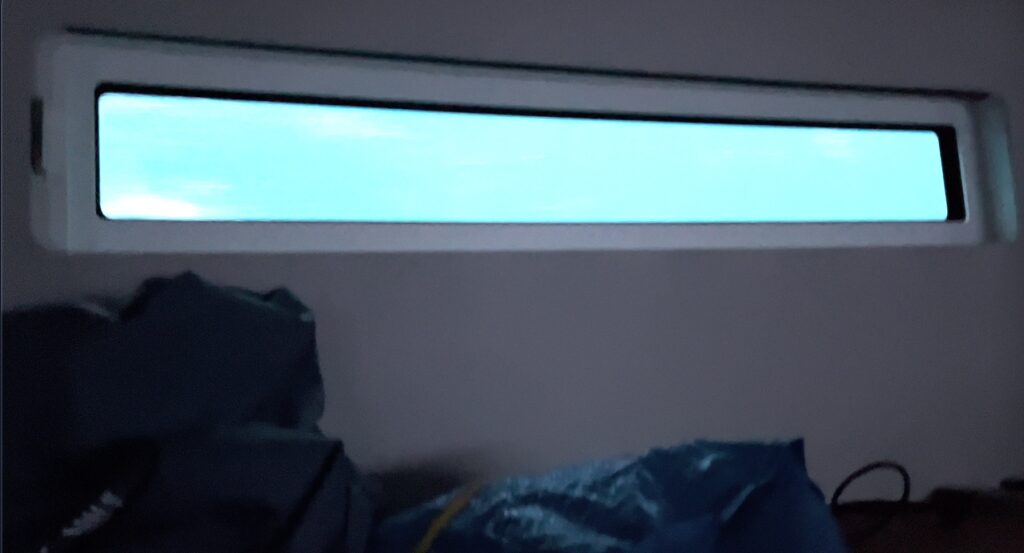
We settled into our watch schedule of 4 hours on and 4 hours off. Don and I took the first watch at 2pm. We put in a second reef in the main as winds hit 27-28 knots. Going down below to add foul weather gear was a slip-and-slide experience until you could secure your feet with something better than wool socks.
With the steep heel angle, and the erratic waves tossing Sea Rose’s bow into the air and slamming down on the water, like a poorly trimmed powerboat, it was no surprise that seasickness would try to make its unwelcome visit, especially for our newly arrived crew dealing with jetlag-abbreviated sleep. Good thing we had two doctors onboard! A friendly visit by a jumping troupe of dolphins helped the spirit as well.

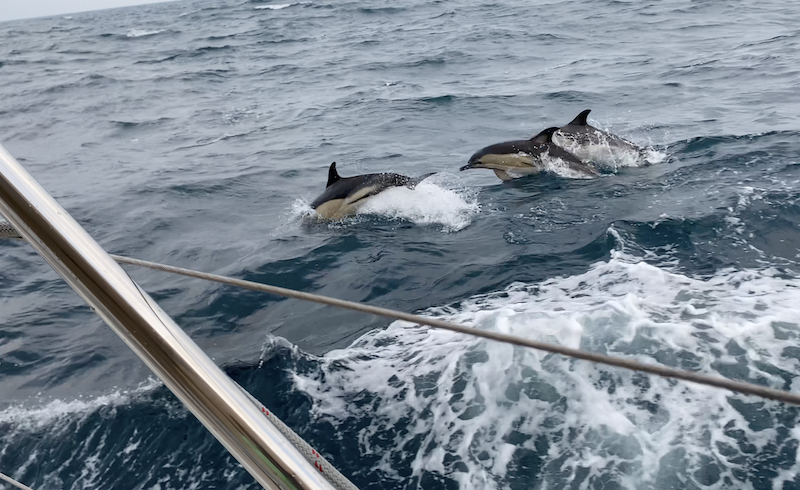
Don was hot-bunking with Dan in our aft guest cabin. It’s not what you think, hot-bunking. On long passages, crew on opposite watches will share a berth, sometimes swapping out a sheet, sleeping bag and/or pillow. There are only so many sleeping locations on a boat of our size at sea, and generally the farther aft you are, the better. Karen and my berth up in the forward cabin is spacious when anchored or on a quiet sea, but equivalent to sleeping on a bucking bronco in these conditions. We instead hot-bunked in the second aft cabin – not really a cabin per-se but rather a workshop. We had recently moved gear around to make it more usable for offshore, and we both found it offered surprisingly good sleep. The key is to have a torpedo-tube style of design, where you are held in position side-to-side so that you don’t awake every time the boat changes heel angle or tacks. It’s normally a giddy moment when you go off watch, with the prospect of sleep coming soon. With our new workshop berth I was practically sprinting to get down there to enjoy its comforts.
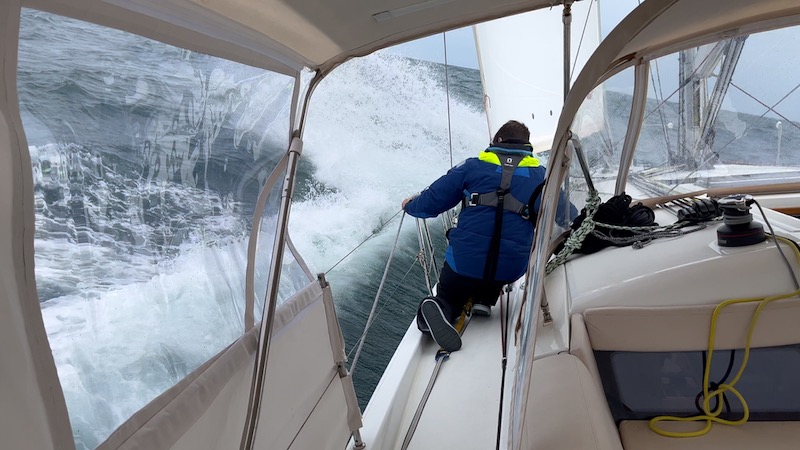
Karen, bless her soul, had pre-cooked a pasta dish back in Sada, and we warmed this up on the gimbaled stove for dinner at the watch change at 10pm. Karen regularly whips up magic back home, but a hearty pasta meal slathered up from a warm bowl in your hands takes on special healing powers offshore.
The sky was just starting to turn dark at 10pm, with the wind easing slightly to 18-20 knots. We were getting a lift – a favorable change in wind direction – allowing us to steer north and eventually slightly east of north, as the wave action settled down into a longer ocean swell period. This is always a welcome change, even if the ocean swell is large, as you can anticipate the peaks and troughs much better than when you are closer to the coast where reflected waves combine to make a washing machine effect on the sea surface. Don and I shook out all but one reef in the mainsail as the wind moderated slightly to between 17-18 knots – pushing us along at a respectable 7 knots. Before we know it, 2 am had arrived and we handed over responsibility to Karen and Dan.
So far the forecast had been dead on, as the wind eased into Day 2 and became non-existent. Sure enough, I could hear the engine being started partway through my off-watch. Even though the workshop is one plywood sheet of separation from a 57hp internal combustion engine, the unwavering white noise disrupted none of my sleep.
At 5:45 am Don and I were both back up again, needing all of the 15 minutes to get dressed in thermal layers, fleeces, foul weather bibs, jackets, boots, hats, gloves, and finally our inflatable lifejackets. A horizon was almost visible in an otherwise battleship gray sky. We continued motoring in seas becoming flatter by the hour as the residual wind subsided.
Both Karen and I recognize the great benefit of having the extra help on watch. Last summer, we did several overnight passages by standing watch alone. By the third hour, you are trying desperately not to nod off. With a friend as a watch-mate, there’s someone to talk to, to help with sail trim, and to spell you off at the helm. On this crossing, even though we used the autopilot nearly exclusively, we always had one person on each watch responsible for navigating. This person would check the course on the chart plotter, making changes as needed, and periodically check the landscape for lights of other boats and the radar and AIS for other boat traffic not yet visible to our eyes. Don and I alternated every 30 minutes at night, and every hour during the day. It was just the right frequency before your attention and alertness began to fade.

As the light came up for Day 2, we started to see long wooden planks floating in the water. Sometimes just one by itself. At other times, there would be several in one vicinity. One hit our bow with a loud thud, but caused no obvious damage. The planks looked like new lumber, without any holes or nails. It’s as if a supply ship lost a whole pile of new lumber off of its deck. They laid low in the water, barely visible. It had the side benefit of keeping us alert at the helm. Don and I motored for our entire watch and then headed down for much needed extra sleep at 10am. This was the blissful kind of off-watch sleep on flat calm seas.
Midday brought the pleasure of hot showers, easy lunch preparation, sunshine and the chance to strip off foul weather gear. We continued to see planks of wood regularly in the water, with one being used by a pair of seagulls hazily resting until we came close by.
In the afternoon, we switched watch partners, as I pair up with Dan. When we both took over at 2 pm, a light breeze gave us a chance to try a gentle beam reach sail and provide some rest to the engine. As we trimmed the sails, the sound of a loud rocket came screeching across the sky behind us, surprising us both out of our skins. It was moving so fast, we couldn’t find it at first, but then it banked and turned back towards us. It ended up being a private jet with a misbehaving pilot. When he returned, he was flying even lower, aiming right for us and passed just above our mast. At times of war and unrest in the world, it’s not as easy to cast off such playful pilot behavior.

The fickle wind led us back to motoring on a rhumb line to Belle Isle, our preferred destination in France. I calculated that we had enough fuel to motor the rest of the way if necessary, but we hoped the forecasted winds for Day 3 would help us along the route. We have no internet service at sea, so we had to hope the forecast when we left Sada was still accurate.
At the point on the chart that marked our entry into French waters, we doused the Spanish courtesy flag, that together with the Portuguese flag, have flown from our spreader since last July, and raised the French flag. It’s a symbolic sign of optimism as we got closer to our destination.

Just before the watch change at 10 pm, Karen prepared a delicious dinner of turkey meat, onions and spices with tummy-soothing rice. Miraculously, it was so calm that we were all able to sit down in the cockpit and enjoy our meal on a level boat, complete with wine. This seemed like cheating – the Bay of Biscay was not supposed to be this placid.

Dan and I continued motoring through our watch, but at the 2 am changeover, Karen and Don killed the engine and tried sailing. The winds were still variable and it was tough at night to sail with no reference point but the instruments. At some point, the loaded jib sheet came untied at the clew and they were forced to tack to the other side. When Dan and I came on watch, we helped rerun the lines, and I was reminded of who originally tied those sheet knots!

We were only making 4 knots of speed in a 6-7 knot breeze but it was fortuitous as we are ahead of schedule. If we were to go any faster, we would have arrived before daybreak on Day 4, a real no-no in the offshore passage textbook. As the sky brightened on Day 3, the wind filled in nicely, but in the form of a ‘header’ that forced us off of the rhumb line course. Still, it was very pleasant and comfortable. The gentle long ocean swell of about 2 meter height passed under Sea Rose causing us to roll slightly but the slow rocking seemed to give the off-watch an extra deep sleep. This didn’t last long. As we got closer to the French coast, the bottom of the Bay of Biscay rises sharply, from an impressive 4400 meters to just 100 meters. This sudden contour change contributes to the Biscay’s bad reputation, as the energy from the prevailing southwest winds and swell get compressed and raise a steep sea. Our winds were from the northeast, but the pervasive SW swell still caused the seas to be confused and erratic. I didn’t sleep well off watch. When Dan and I came back on, the wind shifted to more of a header, and we decided to tack. At this point, Belle Isle was 85 nautical miles directly to windward. I’m usually not a big fan of tacking to an upwind destination. Progress is slow and it takes a lot of concentration to steer close-hauled. We set the autopilot to track a wind angle of 34 degrees and it did a much better job than we could do.


As nightfall approached on our last night of the crossing, a nice lift in the wind direction allowed us to do one long port tack and a shorter starboard tack, to stay equidistant off our rhumb line. It felt good to be inching closer, and our ETA held for a mid-morning arrival. The choppiness from the depth contour change had settled down. It wasn’t the smooth long period ocean swells, but at least it wasn’t an erratic and irregular sea state.

When Dan and I took over at 10 pm, we carefully finished off a simple dinner of gazpacho soup and bread; this was not an evening for lingering over dinner and sips of wine with the boat heeled over.
It always takes me a good 30 minutes to get my foggy head back into the groove of navigating after waking up from the off-watch. Similarly, when we are going off, our brains have been processing information for several hours and are fully awake, so it’s tempting to rattle off the boat status to the new watch, but you have to slow down and repeat information as they try to wake their brains to absorb the new information.
We started seeing the red and green navigation lights of other boats on the water, a sure sign that the coast was approaching. We used the radar full-time now, keeping it visible on one chart plotter while the other showed AIS targets. In a perfect world, all the other boats would show up on both the radar and AIS, but fishing boats often will not transmit on AIS, and sailboats – some big, some small – don’t bother with AIS either, unfortunately. So we needed to relay on finding them with the radar until they were close enough for us to identify their navigation lights. One sailboat was going the opposite way and appeared to be safely passing below us. But every once in a while, their track would show them crossing in front of us. They were on starboard tack and therefore had the right of way, but as the stand-on vessel, you are required to hold your course and speed so other boats can maneuver around you. Finally, we decided not to leave it to chance, and we tacked away. Frustratingly, they changed course and started following us! Karen came up on deck and was as alarmed as we were. I hailed them twice on the radio but got no reply. In the pitch black moonless night, having a boat follow you is not a comforting experience. We trimmed sails for maximum speed and gradually extended our distance from them. Following this by a tack back to our previous course allowed us to put them to our stern.
The passage gremlins kept at work during Karen and Don’s watch. As they executed a tack, one of the jib sheets, while flailing about the deck as the jib crossed over, got fouled on our new whisker pole, somehow the sheet had wedged itself into the jaw end and closed the retainer pin. As they cranked in on the new jib sheet, the bottom end of the whisker pole came off of the mast mount and was hopping along the deck. I came up to assist, and with the help of the deck floodlight, we were able to sort the mess out, and get back on the new tack. A better way to protect the whisker pole would need to be added to the arrival work list.
As Dan and I came on the 6 am watch, the sweep of the lighthouse on Belle Isle could be seen and a faint outline of the land started to form on the horizon. LAND HO! With fading winds and just 15 nm to go, we fired up the engine and pointed the bow to our destination. The overnight tacking had helped, but it was time to wrap this project up.
As the land got bigger, we started to make out the topography – an island flat as a pancake on top, but with steep craggy cliffs at the water’s edge. We headed for Port Goulphar, with an attractive hotel on its bluff and a few boats already using the anchorage. As we pulled in, it was clear with the 4 meter tide change that we wouldn’t have room to safely swing away from the other boats and the shoreline. Fortunately, just next door was a much larger cove, completely empty. We circled to probe for depths, since the chart had scant details, and dropped our anchor in the middle. An immense relief – we had made it!!
After some high-fives, we headed off in the dinghy to officially set foot on French soil. The tide was near low, and there was no obvious place to tie up the dinghy, like a dock that would allow it to float with the incoming tide. We found a section of rocky shore where a primitive set of steps had been cut into stone. Below the high tide line, the steps were full of slippery seaweed. In taking our first few steps, I envisioned one of us slipping and breaking a leg as an introduction to France. Fortunately, we had not lost our agility during the three days at sea. The cliff edge undulated out into the ocean and back into deep crevices. The French government had seen fit to create a nice wide separate walking trail from that of the asphalt road nearby, allowing us to amble along smelling the flowers and taking pictures without fear of being run over by a quiet-but-quick electric scooter, a road biker, or zippy little Renault.

The views were outstanding and other-worldly. At the same time, I felt an immense amount of relief. This was our big hurdle for the summer. It’s possible we may not need to do another overnight, except for perhaps one in the Baltic Sea. I felt relief that without a proper shake-down, we were still able to do the trip without major mechanical issues. And, above all, everyone had a grand time. After our delightful coastal walk, we followed a path inland through farmland to a small Breton-style village that Dan has scoped out for a refreshment. A cold beer, a glass of wine – whatever the elixir – this had been an incredible start to our summer of sailing, and we are so grateful for the hand and the company of our good friends Dan and Don!
Be sure to also checkout the video content on our LifeFourPointZero YouTube channel. We regularly post updates on our sailing adventures, as well as how to videos on boat repair, sailing techniques, and more!

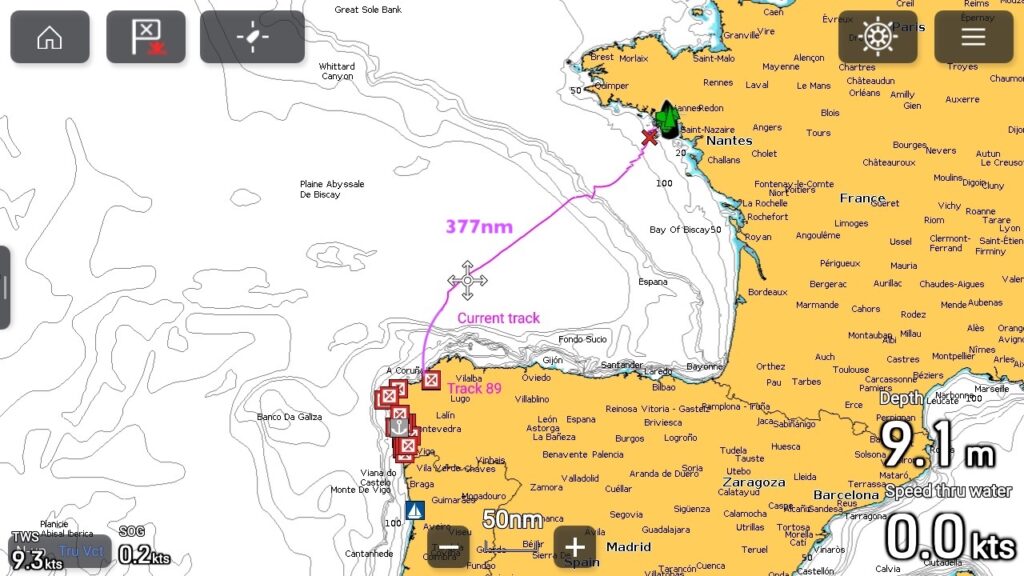


Great update Karen and Tom – happy summer !
Thanks Bill, hope you and Beth have a great summer too!